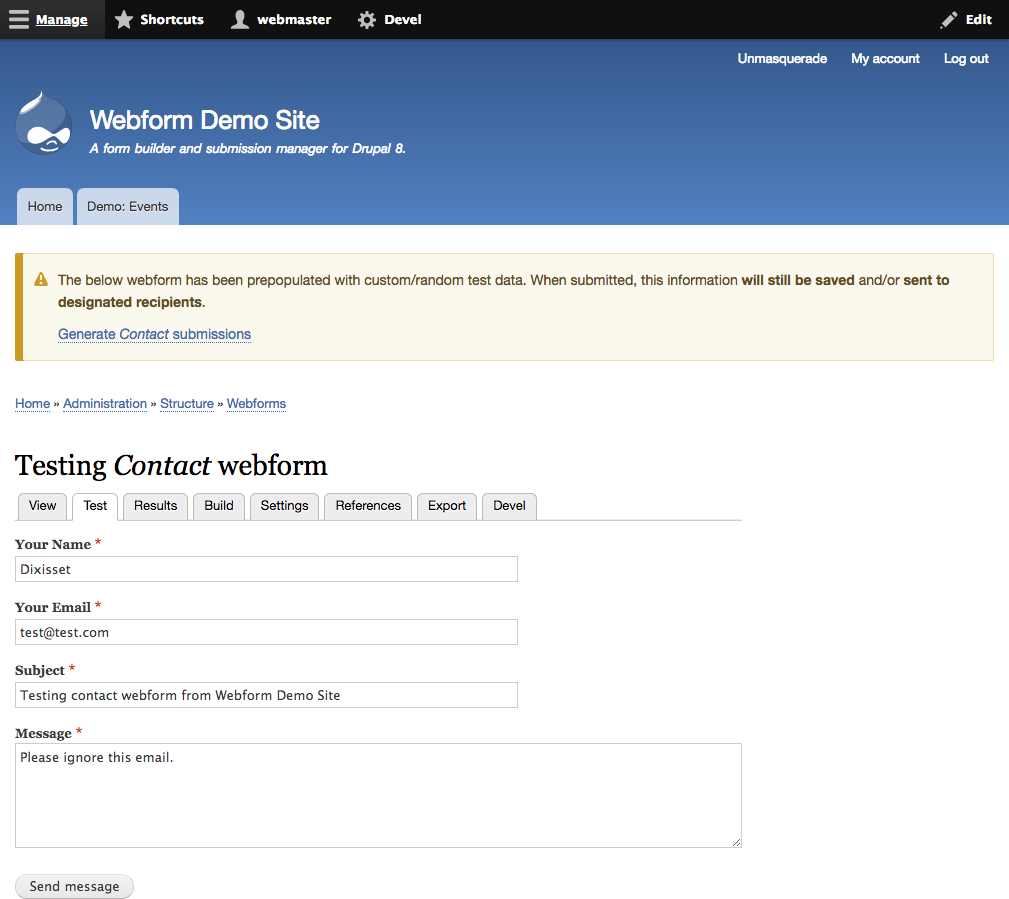

By default, Mime Mail will look for a mail.css file in your theme and will include it in your email template. Mime Mail should also automatically handle converting stylesheets to inline style attributes before sending the email, but you could also inline your styles manually if necessary. Now that we have our email templates, we can begin applying styles to these emails. Other modules may have their own email templates as well, so be sure to check all email messages sent by your site! 4. For emails sent via the Webform module, the template you’ll need is.
WEBFORM DRUPAL TUTORIAL PASSWORD
This template will be used by all account-related emails sent from the system, like account creation and password recovery. You can skip module-specific configuration unless you find that you need it for your specific use case.īy using the Mime Mail formatter, we have access to a template named that we can override in our theme. Finally, set the theme to render the emails to your active theme. We’ve seen the best results with the combination of using Mime Mail mailer as the Formatter and SMTP Mailer as the Sender. Here, you’ll set your mail formatter and sender. Once your modules are installed and enabled, head over to the Mail System configuration page (Configuration > System > Mail System). There are many different modules out there, I’ve had the most success with the combination of these three modules: Mail System, Mime Mail, and SMTP. In this tutorial, I’ll explain step-by-step the process to enable and style custom HTML emails in Drupal 8. The design of these emails is therefore an important touchpoint that should not be forgotten about. There are also several custom webform element properties and settings available to enhance a form element's behavior.From form submission confirmation messages to password recovery requests, system emails are an important part of any website or application. Computed: Calculated values using Tokens and Twig with Ajax support.Īll of Drupal's default form element properties and behaviors are supported.Composites: Name, Address, Contact, Credit Card, and event custom composites.Markup: Dismissible messages, Basic HTML, Advanced HTML, Details, and Fieldsets.Widgets: Likert scale, Star rating, Buttons, Geolocation, Terms of service, Select/Checkboxes/Radios with other, and more.

Advanced Drupal: File uploads, Entity References, Table select, Date list, and more.

Advanced HTML5: Email, Url, Number, Telephone, Date, Number, Range, and more.Basic HTML: Textfield, Textareas, Checkboxes, Radios, Select menu, Password, and more.

Every form element available in Drupal is supported by the Webform module. The Webform module is built directly on top of Drupal's Form API. Drupal (and Webform) will always be free.
WEBFORM DRUPAL TUTORIAL LICENSE
It's distributed under the terms of the GNU General Public License (GPL). It's built on principles like collaboration, globalism, and innovation. Anyone can download, use, work on, and share it with others. The Drupal project is open source software. Assistive technologies, including screen readers and keyboard access, are fully supported.īesides being a feature rich form builder, the Webform module is part of the Drupal project's ecosystem and community. Whether you need a multi-page form containing a multi-column input layout with conditional logic or a simple contact form that pushes data to a SalesForce/CRM, it is all possible using the Webform module for Drupal.ĭrupal and the Webform module strives to be fully accessible to all users and site builders. Every single behavior and aspect of your forms and its inputs are customizable. The Webform module allows you to build any type of form that can collect any type of data, which can be submitted to any application or system. The Webform module for Drupal provides all the features expected from an enterprise proprietary form builder combined with the flexibility and openness of Drupal.


 0 kommentar(er)
0 kommentar(er)
